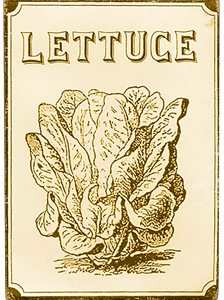LETTUCE
Vitals
• Lactuca sativa , belonging to the sunflower family, Asteraceae/Compositae.
• Origins: Mediterranean, probably Egypt.
• Early archeological evidence: Egyptian tomb paintings from AD 2500 show bundles of lettuce.
• Early literary reference: Herodotus wrote that lettuce was used in Persia in AD 550.
• Climate: Cool (below 80 °F; 26 °C) Mediterranean climate.
• Major producing countries: China, United States, Spain.
Short historyFew plants can claim the title of being both an aphrodisiac and a sleep inducer, a representation of both male sexual power and female allure. But this leafy descendant of a garden weed has garnered its share of mythology. Lettuce was probably first cultivated in Egypt for an edible oil, still used today, that's derived from its seeds. The Egyptians grew a stem lettuce similar to romaine, which they saw as phallic. It was sacred to their god Min, who held power over reproduction. The milky fluid in the leaves was compared to semen as well as to mother’s milk. It contains a sedative, which led to its use to treat insomnia and, oddly enough, excessive libido.
Lettuce facts and loreLettuce may have started its farm life as a weed in wheat and barley fields, where it was tolerated until farmers began to cultivate it for its seeds.
Firm, round heads of lettuce such as iceberg were bred to withstand the rough handling of machinery and long-distance travel.
The lettuce harvest became a source of contention between United States farm workers and growers in the 1970s. Striking workers and an international lettuce boycott were instrumental in the passage of a California Bill of Rights for farm workers in 1975.
Lettuce, one of the most popular foods in the modern Western diet, must be eaten fresh. It can’t be frozen or dried like most other vegetables.
Saving the seedLettuce seeds are easy to save, and the seeds will remain viable for about five years.
• Lettuce plants like cool weather. When temperatures rise and days get longer, the plant is more likely to bolt (send up a flower stalk). If you want longer-season lettuce, save seeds from the plants that bolt latest.
• You can plant more than one lettuce variety in your garden. To assure that there is no cross-pollination, make sure to separate lettuce rows by at least 20 feet (6 meters).
• Outside leaves of the plant can be harvested without jeopardizing seed production. But leaves will begin to taste bitter once bolting has started.
• As the bolting stalk grows, it will become quite tall and develop small yellow flowers. Each flower produces one seed.
• Lettuce seeds come to maturity at different times. When you see dark seeds, you can shake the plant over a paper bag to catch them. They should need little cleaning when harvested this way.
• Store seeds in a sealed container in a cool, dry area.
Note: Make sure that the lettuces you are saving seed from are what’s called an “open-pollinating” rather than a hybrid variety. For a list of companies that sell seeds for open-pollinating plants, and more information on the importance of seed saving, see our article Why Save Seeds?
